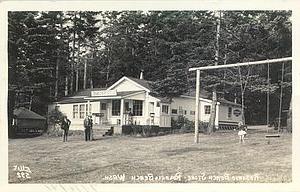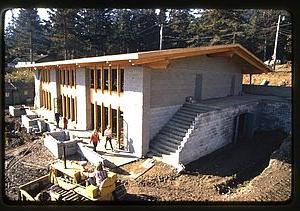The history of 罗萨里奥海滩海洋实验室 at 沃拉沃拉大学
In 1938 the 生物科学系 at Walla Walla College offered its first outdoor summer school. Similar extended experiences occurred in 1939 and 1941. During WWII these extended trips were not possible, but in 1946 thirty five students went on a six-week expedition into the Canadian Rockies. In 1947 it was decided that instead of a "traveling school", a more permanent site on salt water should be established for the study of the marine environment in a Christian setting.
那年夏天,博士. 欧内斯特年代. 展位, chairman of the 生物科学系 at Walla Walla College and a strong proponent of field natural history, held classes in a rented fish cannery three miles west of Anacortes (the remains of which can be seen adjacent to the Anacortes ferry terminal). From 1947 to 1954 展位 continued to hold summer classes at the cannery. Enrollment each summer ranged from 50 to almost 200 students. Though inexpensive (展位 rented the cannery for $1 per summer), space and facilities in the cannery were rather limited. In 1954 展位 began looking for another more permanent site for a biological field station.
在20世纪20年代早期, 亨利·格雷厄姆和他的儿子, 约翰, purchased land on Fidalgo Island adjacent to the Military Reservation, now part of Deception Pass State Park. The Grahams built cabins and developed the property into the Rosario Beach Resort. 1946年3月, the Grahams sold the resort to Gilbert and Margaret Hull, 该地区的长期居民. At that time sheep grazed on open range along the grassy slopes above the property; several cabins were clustered toward the north end of what is now the marine lab's beach; and a utility shop was situated at the site of today's residence hall.
The dining hall (removed in December 1999) was the Hull's residence and variety store. The store featured newspapers, food, fishing tackle, and other items popular among vacationers. By 1953 the Hulls had tired of the unrelenting responsibility associated with operating a resort and decided to sell. 价格? $53,000. When 欧内斯特 展位 saw Rosario Beach Resort in 1953, he knew he had found the right place for a biology field station.
Fearful of losing the property to another buyer, 展位 emptied his personal savings account ($15,000) for earnest money - and then notified the college of what he had done. George Bowers, president of WWC at the time, was understandably shocked. "I've gotten you out of many a problem, 欧内斯特,鲍尔斯告诉他的朋友, "but I don't know if I can get you out of this one. You may have just bought yourself a marine station."
Although the board members did not want to approve the purchase merely to remove their headstrong professor from a financial predicament, they realized that "it is desirable that Walla Walla College have a more respectable station and that Rozario [原文如此] Beach property offers this better location." 展位's purchase was approved on August 9, 1953, but only after the board voted unanimously that in the future 展位 should make no financial commitments without prior approval. In 1955 the first summer session at Rosario Beach had begun.
Since 1955 Rosario has seen many changes. One dramatic change was the demolition of the old lab buildings and construction of new laboratory facilities in the 1970s. The first and larger of the two buildings, constructed largely by volunteer labor in 1974, 被命名为欧内斯特. 展位 Laboratory in 1983 in recognition of his pioneering courage and foresight in the establishment of the marine lab. Four new cabins were completed in 1994, six additional new cabins in 2001, and six more in 2014-16. May 2001 witnessed the dedication of a new cafeteria, Lindgren Hall. In 2007 the official name of Rosario was changed to the 罗萨里奥海滩海洋实验室.
While students and staff enjoy the the new facilities, Rosario retains its quaint charm and sense of history - and some students still reside in the simple cabins built by 约翰 and Henry Graham in the 1920s.

